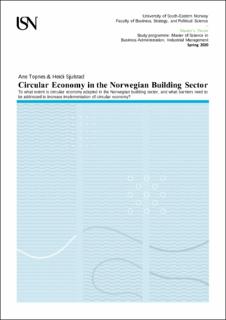| dc.description.abstract | With a rapidly growing population, the world requires more access to natural resources, housing, and jobs. Natural resources have been extracted and used at a high pace over the years, and access to these resources have become more limited as years pass. If humans continue the use of virgin materials at the pace they do today, the world will not be able to regenerate enough of its resources to keep up with the demand. Hence, we argued there is a need for a more sustainable way of keeping these resources in check. We found circular economy to be a countermeasure to this, as circular economy aims to utilize resources and materials more efficiently. A product in circular economy is designed to last longer and to not generate waste. By designing the product to be utilized beyond its original life cycle, one can use materials and components over again, either with the same purpose or a new purpose. A result of this would create less waste and less use of virgin materials, and a greater focus on reusing what we already have available.
We found the building sector to be fitting context for our study. Aside from the benefits the sector provides, such as jobs, housing and major contribution to the global economy, it also comes with a series of negative impacts on the world. These impacts are often related to climate and environmental challenges. As circular economy has gained more attention over the years, especially with the increased focus on sustainability, we found it interesting to see how circular economy was adapted in the building sector. The Norwegian Government reported that Norway should be a leading nation for circular economy. We also discovered that there was a low grade of implementation of circular economy in the Norwegian building sector and wanted to understand why.
Hence this study seeks to develop a deeper understanding of the phenomenon of circular economy in the Norwegian building sector. This study aims to answer; “To what extent is circular economy being adapted in the Norwegian building sector, and what barriers need to be addressed to increase implementation of circular economy?”
By developing an understanding of why the situation is as it is, we can provide the sector with an overview of what need to be addressed in order to move further with implementation of circular economy. This study could be helpful for the building sector finding a common ground, both with circular economy and potential barriers they need to address in order to evolve and become more sustainable. As the building sector is in a more or less dominant position, successful implementation of circular economy could serve as a great inspiration for other industries.
From our theoretical framework, we discovered that circular economy was a term with vast and many definitions, as well as many surrounding concepts. On the area of implementation, the extent of research was somewhat insufficient, especially for the Norwegian building sector. The existing research were mainly focused on theoretical aspects, and there was a lack of examples on successful practical implementations. Some barriers were identified for the building sector in general in regard to implementation of circular economy. Barriers for implementation of circular economy in Norwegian building sector were an area much less researched.
When we conducted our study, we gained a lot of insightful information to supplement our theoretical findings. We found that the focus on sustainability has increased in the Norwegian building sector, mostly due to the push from EU. The focus was somewhat varied, in central areas and bigger firms the focus was clearly higher. It was clear that the wheels have started to turn in order to shift towards a more circular economy in the Norwegian building sector. We were able to gather insight on specific measures towards this transition. What we realized was that there was a great focus on reuse, which is only a small part of what circular economy actually entails. We found that circular economy requires one to see the bigger picture, also from a long-term perspective. We still feel that the building sector has a long way to go, although the initiatives are there. Yet we also believe this to be a result of the unclarity of what circular economy entails.
Currently the building sector is still in the process of trial and error, and some pilot projects have taken place. The current measures implemented is an enabler for shifting the way of thinking, and an important step in order to reflect on how things could be done differently. We found that measures ideally should be considered from an earlier stage, where design plays an essential part, and that this will result in a more long-term view, where you also could have a more holistic approach.
The main barriers we found which needs to be addressed in order to increase further implementation were divided in to five areas. These barriers were; 1. Cultural, such as knowledge and the need for supply chain collaboration. 2.Economical, such as the costs of implementation. 3. Sectoral, mainly related to reuse, where challenges regarded existing buildings, lack of efficient processes for quality assurance and testing, and time. 4. Regulatory, mainly providing challenges for reuse. 5. Market barriers in regard to lack of demand from customers and the need for a market platform in order to perform more reuse. | en_US |
